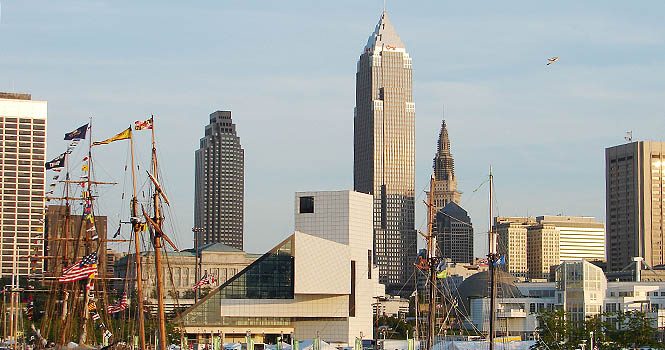Cleveland Urban Design Collaborative partners with city on green innovation
Cleveland’s skyline offers visiting tall ships moored along the shore of Lake Erie. Photo courtesy of MCT Campus.
February 27, 2012
Under Mayor Frank Jackson’s push for a more sustainable Cleveland, Kent State’s Cleveland Urban Design Collaborative gained national attention for its work providing sustainability concepts to the city.
“Re-imagining a More Sustainable Cleveland,” an initiative involving the Cleveland Urban Design Collaborative, the City of Cleveland, Neighborhood Progress, Inc. and ParkWorks, won the 2012 National Planning Excellence Award for Innovation in Sustaining Places given by the American Planning Association.
Over the course of a couple of years, the groups worked to address population decline in the city and how to combat vacancy due to the decline, said Terry Schwarz, director of the Cleveland Urban Design Collaborative.
“’Re-imagining a More Sustainable Cleveland’ is a planning project that looks at how you can repurpose this surplus real estate in order to kind of remake and reclaim the city,” Schwarz said. The work was nominated jointly by the CUDC and the City of Cleveland.
The CUDC has two parts. The first part is composed of 20 to 30 graduate students completing a master of architecture, a master of urban design or both simultaneously. The second part is a nonprofit urban design practice with a five-person staff.
“We’ve noticed that the work we’ve been doing through ‘Re-imagining Cleveland’ has definitely sort of filtered into the studios that our students take and also to their capstone projects,” Schwarz said. “They’ve become kind of interested in the same work that the CUDCs design practice has been tackling.”
In 2009, Mayor Jackson launched a 10-year sustainability initiative called Sustainable Cleveland 2019. The goal is to create a green city on a blue lake.
“We know here in Cleveland that sustainability is the future of our economy if we are going to have a thriving and resilient Cleveland,” said Jenita McGowan, chief of sustainability for the City of Cleveland.
In September, the city passed legislation for complete and green streets. The ordinance says when the city builds new streets or does reconstruction, the roads have to be built for all modes of transportation and all ages of users. They also look at how to make streets environmentally beneficial, McGowan said.
“We’re committed to looking at bicycle and pedestrian infrastructure in addition to motor vehicle infrastructure,” McGowan said. “We’re committed to looking at how a street can be used to capture storm water instead of create runoff, as well as using recyclable materials and energy efficient fixtures.”
The CUDC is teaching a class around complete and green streets and partnering with the City of Cleveland to build a temporary installation of a complete and green street to demonstrate the idea for the community, McGowan said.
Schwarz said every major city in Ohio except Columbus is declining in population, and it is a trend in the entire Great Lakes region. The work on sustainability by the CUDC and the City of Cleveland can be beneficial on a larger scale.
“The challenges that Cleveland faces are not ours alone. I think that’s why the American Planning Association gave this project this award,” Schwarz said. “Not only has it been useful in the City of Cleveland, but they see opportunities for other cities to kind of translate some of the research and some of the design practice to address the challenges in their own communities.”
Contact Nicole Aikens at [email protected].

























